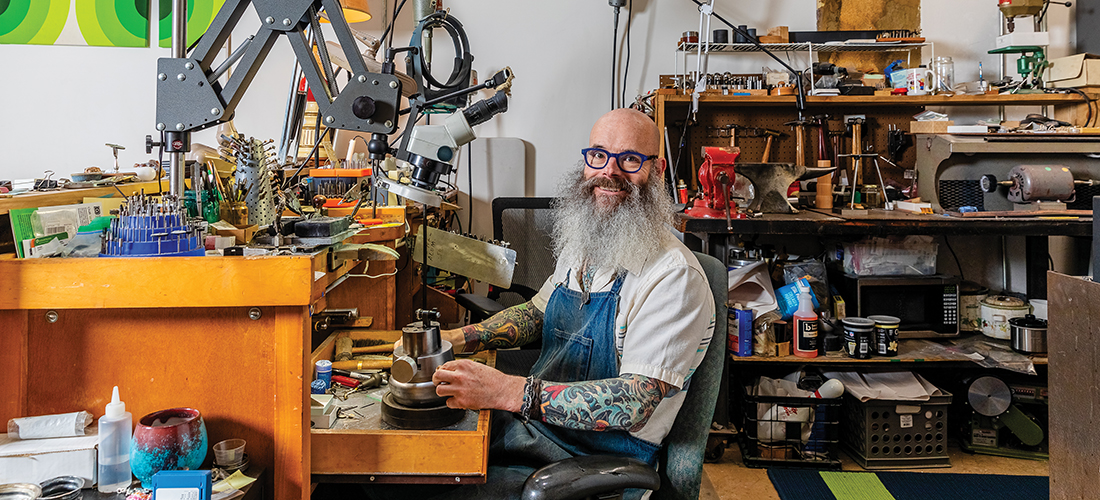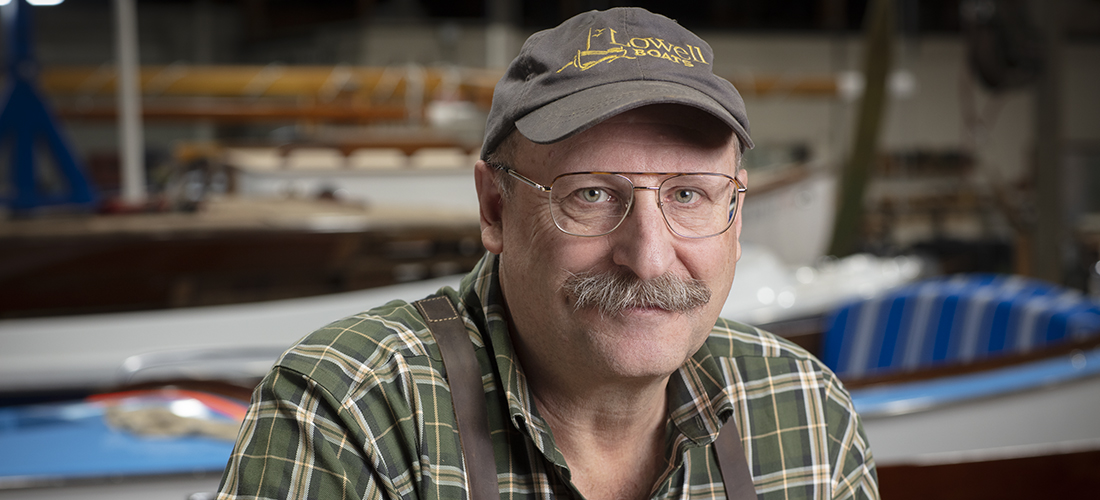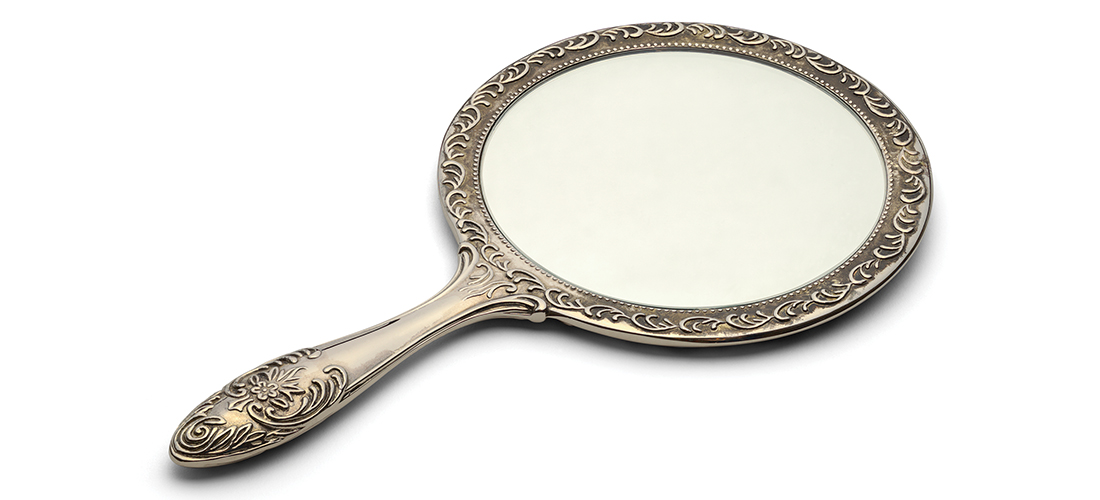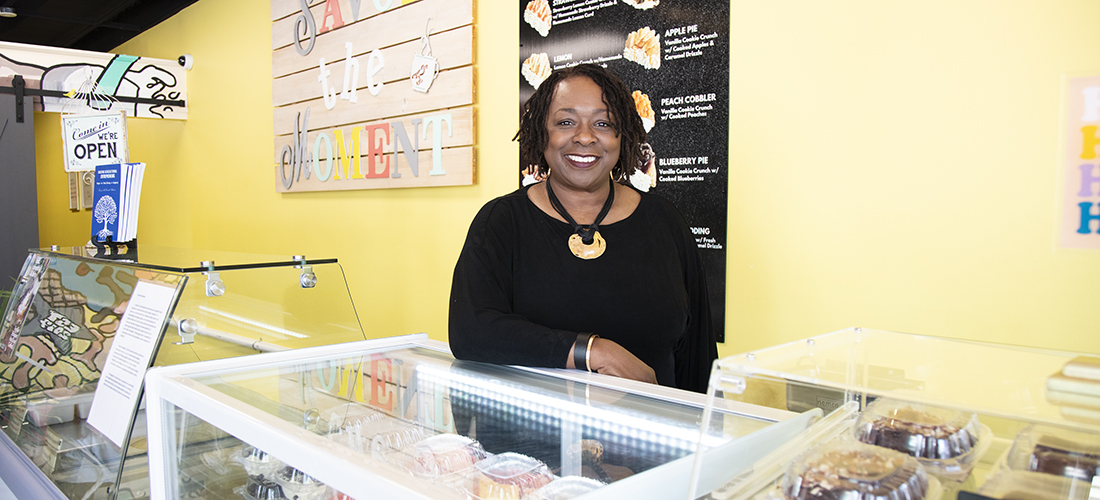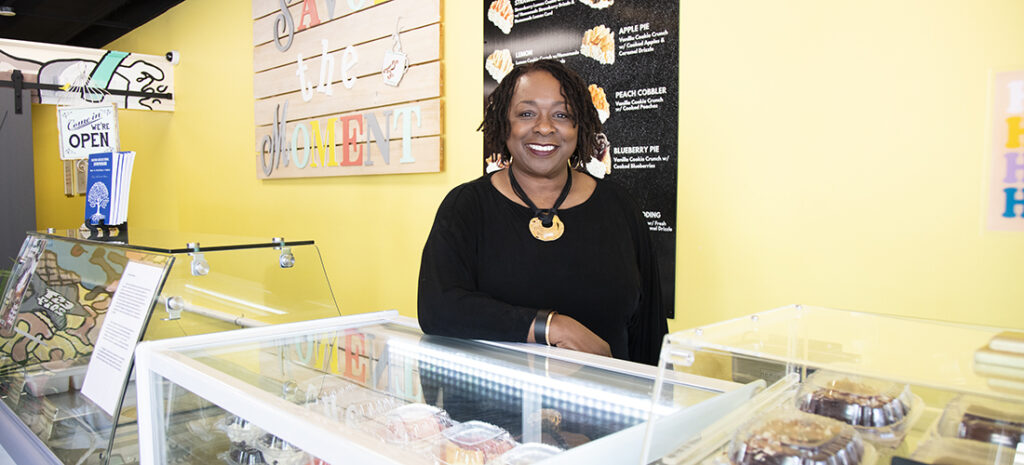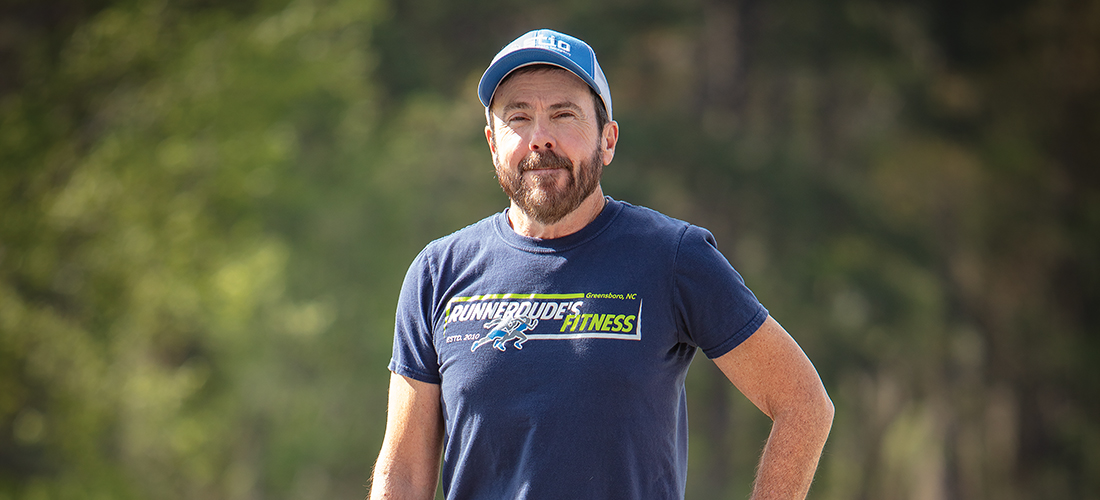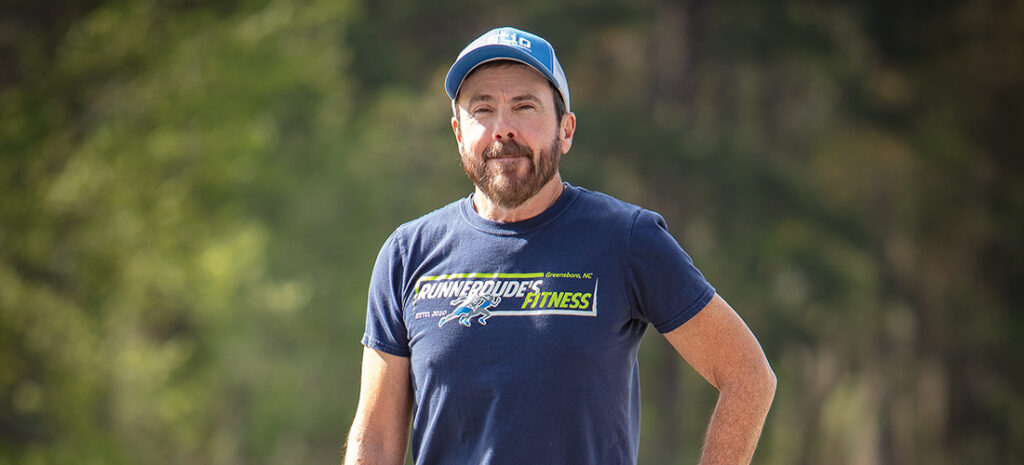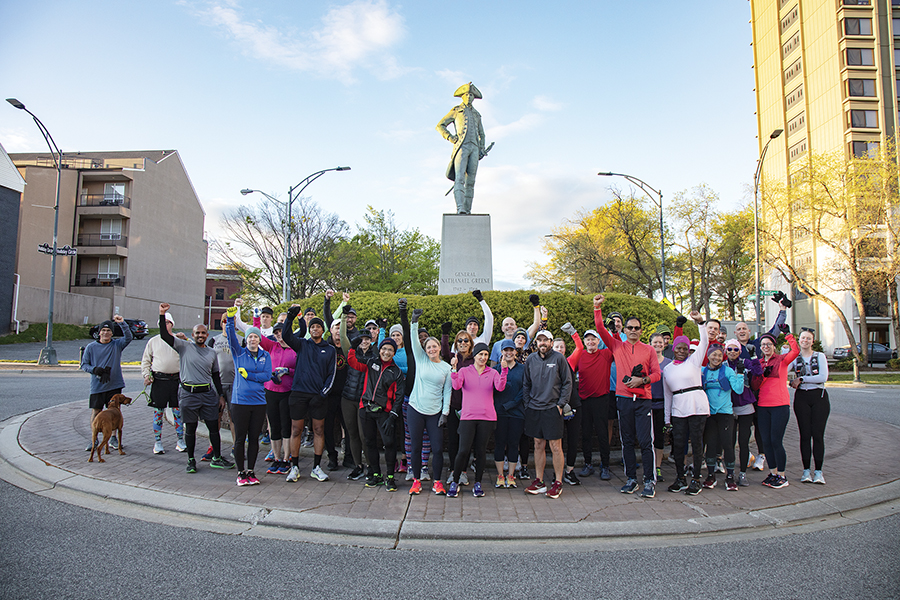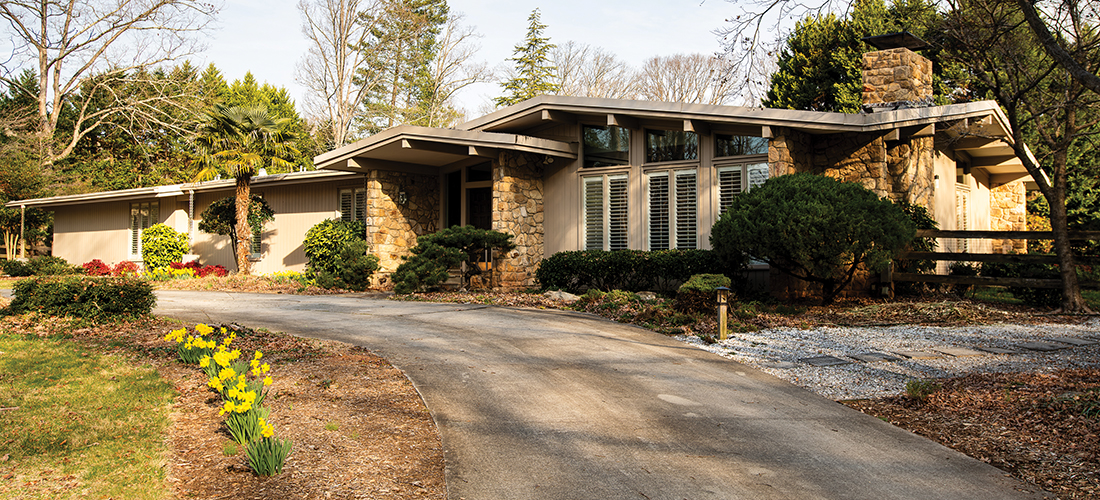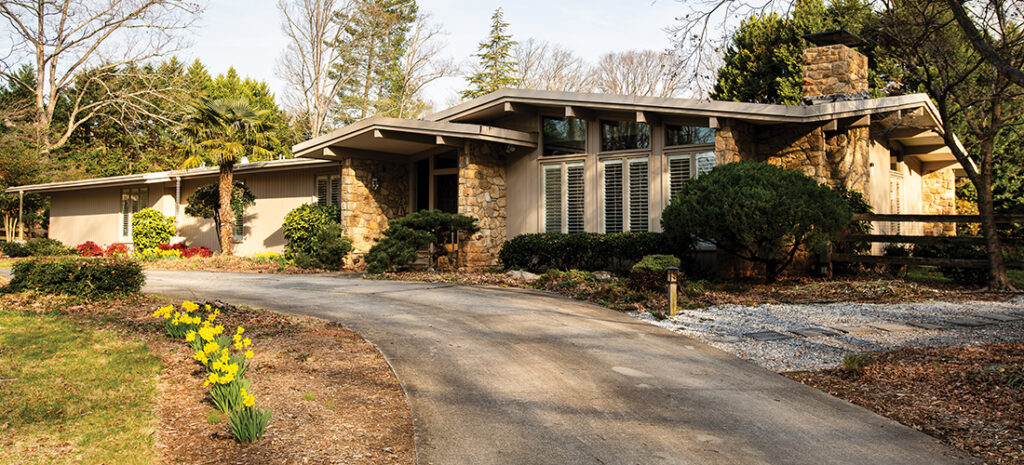Thinking Outside the Jewelry Box
Thinking Outside the Jewelry Box
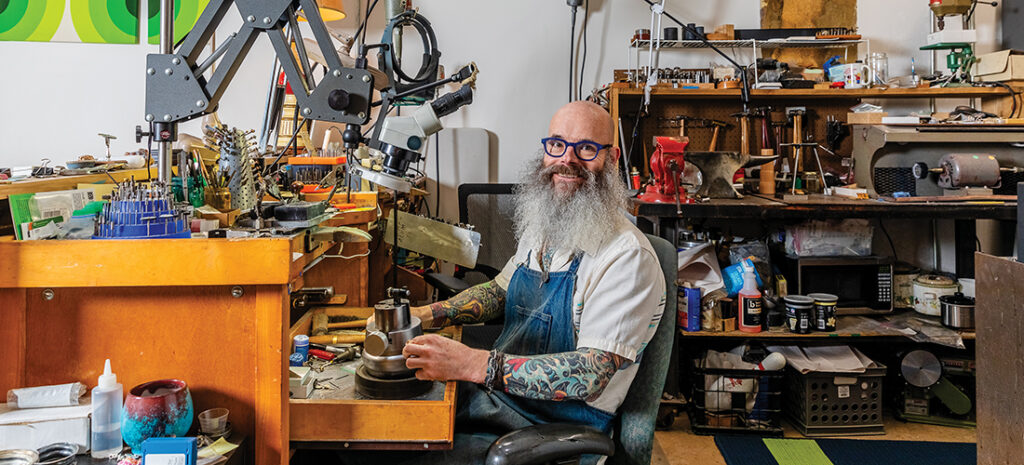
With his grandfather’s tools, Jake Wosinski makes his mark on McGee Street
By Cassie Bustamante
Photographs by John Gessner
Behind the jewelry case at Jacob Raymond Jewelry on McGee Street sits the artisan and proprietor. His bald head is counterbalanced by a large, full gray beard and atop his long, narrow nose sits a pair of blue-framed glasses behind which dark brown eyes peer outward. The sleeves of his plaid shirt are rolled up to his elbows, revealing tattoos on both forearms. In short, Jake Wosinski, 52, is not someone you’d expect to be selling engagement rings.
And yes, you read that right: His last name isn’t Raymond. The Raymond in his shop’s name comes from his grandfather — his father’s father — who first sparked his interest in jewelry making. In fact, Wosinski still uses many of the tools he inherited from his grandfather. He holds out a pair of dividers engraved with a patent date of June 2, 1885, by Starrett, a company that Wosinski notes is “still in business in Boston, still making these.” The dividers also feature the engraved initials of those who have used them before. Pointing to a tiny set of curlicue letters, Wosinski says, “And so I scribed my initials on there.”
Among the tools he inherited and uses on a daily basis are these nearly 140-year-old dividers, a large polisher and a steel ring mandrel, which aids in shaping and sizing. While he isn’t sure how far back the mandrel goes, it dates at least to the ’50s because it bears the inscription of a name familiar to Wosinski: George Beaudet.
Beaudet was the jeweler who originally taught Wosinski’s grandfather, Raymond, the craft in Milwaukee, where Wosinski originally hails from. When Raymond moved to California — where Wosinski’s own family headed soon after — he took his skills and tools with him and continued the trade. “I kinda grew up around it,” says Wosinski.
While the first jeweler in the family that Wosinski can recall is his grandfather, he comes from a long line of men who’ve worked with their hands. “Most of my family on my dad’s side were tool and dye makers, or mold makers,” he says.
He thought he’d follow suit, but decided to attend the University of South Carolina Upstate in Spartanburg, where his family had relocated when he was 16. He began working toward earning a degree in English, but the family once again moved, this time to Greensboro. After working for a year, he planned to switch gears and study structural engineering at N.C. State as soon as he qualified for in-state tuition. “But I never made it back [to college].”
Wosinski’s brother, Brad, worked with a bartender who also happened to be a gemologist. Through him, Wosinski discovered the Gemological Institute of America and, at the age of 20, began a correspondence course. The institute would send him gems to identify with equipment he’d purchased — a microscope, a polariscope and a refractometer. From there, he ventured into a gem-cutting class at Randolph Community College.
The class itself bored him, but in it he first learned about the Sawtooth School for Visual Art in Winston-Salem. He enrolled in a jewelry making course that would change his life. “As soon as I took that class, I was like, yeah, this is what I am doing.” At that moment, the dream of having his own jewelry business one day was born.
Had he always been an artist? In training, no. “Maybe I could have done better if I had taken an art class,” he says, “but at the same time, since I don’t have rules of art or whatever, I am just doing whatever I want, thinking more outside of the box.”
A man on a mission, he sold his motorcycle to buy the tools he needed, set up shop in his parents’ garage and tried to get a job working for a jeweler. Lacking experience, “No one would hire me,” he says. “Finally, I went into a jewelry store and said, ‘I will work for you for free. Just let me learn.’” A shop in Winston-Salem took him up on the offer. After two years, he left in search of a paying job. Despite his experience, he still came up empty.
Not willing to give up, Wosinski decided it was time to attend an actual jeweler’s school and left for the now defunct Atlanta Jewelry Institute. Lo and behold, right after graduating, he landed his first paying jewelry job at a Greensboro store where he did repairs.
“But I wanted to make jewelry,” adds Wosinski.
Next stop? A shop in Winston-Salem, where he worked for six-and-a-half years.
“I made lots of awesome jewelry,” he says, “but it wasn’t my design.” At the same time, Wosinski worked on designing and creating jewelry at home, with plans to create wholesale pieces to sell to stores — both one-of-a-kind pieces as well as manufactured pieces that he could reproduce in mass. When he wasn’t at work, he was building his inventory in preparation of launching that business. In the meantime, he’d also gotten married to his wife, Liz, and had three young kids at home to consider.
“It was just too much,” he says. “I thought, ‘I will never see my family.’” Being the sole provider, he opted instead to look for a job where he could continue to hone his skills and offer design services while waiting for “a later date” to pursue a business of his own.
Armed with a collection of his designs, Wosinski went to an interview at a Chapel Hill jewelry store. “[The owner] actually bought $3,500 worth of jewelry at the interview!” Naturally, he was hired and the family relocated to Mebane to be closer to his job. While there, rings he designed won 10 American Gem Trade Association Spectrum Awards. But because it wasn’t his shop, his name was not on the awards.
After 10 years there, “a later date” had arrived. It was finally time to take a chance on his dream. He’d mentioned to his friend, Nate Hall, owner of Legacy Irons Tattoo Co. on McGee Street, that he was contemplating a move back to Greensboro and wrestling with the idea of finally opening his own place.
“He basically said, ‘Well, the jewelry store two doors down? I think they want out of their lease.’”
The landlord, Jeff Yetter, confirmed and put Wosinski in touch with the shop owners.
“We were at the grocery store on a Saturday night and I get a call,” he says. The jewelry store owners were heading out of town for six weeks and told him that if he wanted to come take a look, he could come now. Or he’d have to wait.
“We bought our groceries, went home, hopped in the car and drove to Greensboro.”
As luck would have it, the owners wanted to sell their jewelry cases and safe, items that would have been costly at startup. Everything was outfitted exactly as he’d need it.
He recruited his former Winston-Salem employer to come take a look at the shop and share her thoughts. Her response? “You need to do this.”
It felt as though it was meant to be, Wosinski muses. After working his last Friday in Chapel Hill, he opened the doors to Jacob Raymond Jewelry for the first time the following day and assumed his business, like that of his previous employers, would go “gangbusters from the beginning.”
And? “It didn’t go as planned,” he admits. “I don’t know anything about running a business.”
After a year of commuting from Mebane, the family moved to Greensboro, renting a home and using the equity from the sale of the previous house to survive. Bank accounts dwindling, Wosinski feared that his dream was over, that he was doomed to failure. What are we going to do echoed in his mind.
Liz had left behind her own job with the move and struggled to find employment in Greensboro, but still, she remained supportive.
“That kind of financial difficulty and hardship can make a couple draw apart or fight,” he says. “We just leaned into each other more. And we did a lot of praying.”
Wosinski admits that he holds a certain amount of pride in his natural talent and capabilities. And God was just taking him down a notch, saying to him, “You’re taking credit for things I have done.”
So that financial struggle? “God was just showing me, you may be great at this, but unless somebody comes in the door and buys it, you’re done.” It was, for Wosinski, a lesson in humility.
Slowly, organically, the business picked up steam. Liz now handles the company’s managerial tasks, such as shipping, accounting and banking. “Every year we’ve been here, we’ve grown.” While it’s not the growth he’d envisioned, his circle has widened and he enjoys the sense of community cultivated by downtown Greensboro business owners and regulars. And he’s able to do what he loves— create one-of-a-kind jewelry pieces. Award-winning one-of-a-kind pieces. Since opening his doors, he’s won two awards under his own name: the 2018 Platinum Innovation Award in the evening wear category and the 2020 Platinum Innovation Award in the bridal wear category.
No surprise there. His favorite pieces to create? Engagement rings. “That’s always like, this is for life,” he muses.
His designs begin, he says, in his design sketchbooks. He’s currently on his fourth. Inside, he loosely draws a plan just to get an idea out of his head and onto paper before it’s forgotten. “But then, every time I go to start making a ring,” he says, “other ideas pop into my head.” It’s very rare that a final product matches its original design. And most often, he notes, his pieces are “one and done” — no other in the world exists.
“As you can see, I’m all over the board,” he says, peering over his glass case filled with all sorts of bejeweled oddities. The artist in him appreciates — and designs — in a variety of aesthetics, from Art Deco to his “contemporary estate style. I love doing what I call my ancient style, which looks like something from the Middle Ages or Roman times.” A cuff bracelet looks like something that would have graced Cleopatra’s arm.
Wosinski loves working with sapphires because of their durability and the rainbow of colors they’re available in, but what really sparks him is fire agate. This rare opalescent stone shines in oranges, greens and purples, and is found in the American Southwest as well as northern Mexico. What appeals to him about this stone is exactly what appeals to customers about his jewelry: “Every one is different.”
Sparked by fire agate’s kaleidoscopic luster, Wosinski is determined to create a market for it. According to crystaldigest.com, fire agate is associated with passion and creativity and “is said to help one actualize their highest potential.”
These days, though most clients come to him locally, he serves several customers across the states — even across the globe. He recently completed two custom pieces for a doctor from the U.K. “He’s been following me on Instagram for years, threatening to have me do something for him,” Wosinski quips. Finally, the doctor made good on his promise and visited the United States, bringing with him a 44-carat lab-grown sapphire and a 22-carat lab-grown ruby. He dropped his gems off in November with plans for a March return and pickup.
With those gems, Wosinski crafted a pendant that resembles an amulet and a ring. The doctor’s reaction? “He was like ‘aaaah’ and I was like, ‘Is that a good aaaah or a bad aaaah?’” Palms sweating, Wosinski stood by with bated breath. “It was a good 30 seconds before I knew that he liked it!” After all these years, Wosinski admits that nerves strike when presenting custom orders.
Back on U.K. soil, the doctor sent Wosinski a message: “Thank you for making my dreams come true in jewelry form.”
As for his own dreams? He’s still taking it day-by-day. Since 2017, he’s had only one employee other than himself, and that’s his dad, who — much like he once did — works for free. “I pay him with pretzels and peanuts,” he says with a laugh.
He hopes that perhaps his own 23-year-old son will take an interest and join him down the road. No pressure, though: “We all have our path that we need to go,” he notes.
The ultimate goal is to have a team of employees who can work with clients on custom orders but also create pieces of their own design. He dreams of one day employing jewelers he can mentor, and yes, they’ll be allowed to label it with their own names.
But he’s not there yet. “I can still go two days and not have anybody walk in.”
Just then, the shop door chimes, announcing a customer.
“Hi there!” Wosinksi greets her. “What can I help you with?”
“I want you to make me a ring,” she answers. She tells him that her daughter, a client, says he’s the go-to guy to for custom work.
Woskinski’s face lights up at the opportunity to make her something, something beyond anything she could ever imagine. OH
One and Done
 In 2003, just before our wedding, my soon-to-be-husband, Chris, and I stepped into a tiny jewelry shop in New Orleans. Our mission? The rings, with which we’d wed.
In 2003, just before our wedding, my soon-to-be-husband, Chris, and I stepped into a tiny jewelry shop in New Orleans. Our mission? The rings, with which we’d wed.
As we perused the glass cases, Chris selected a simple, wide, gold band for him. And for me? I looked up and down that store, waiting for something to speak — no, sing — to me. After all, this was eternity we were talking about here!
In the end, under the pressure of time, I chose a $40 plain, gold band “for now” that was similar in width to the diamond ring that had been handed down from his grandmother and which I happily wore for years. It was made from simple, yellow gold, with a solitaire diamond. (I’m told her first ring was prettier, but she lost it in the ocean.)
For years, I was too busy raising kids to think about replacing my “for now” ring with my “forever” ring. Though I loved honoring tradition, truth be told, the diamond was constantly snagging on things and I was afraid I’d be responsible for losing Chris’ grandmother’s second diamond. Buying a third was not an option at the time, so I took it off.
When we moved to Greensboro in 2019, Liz Wosinski reached out to me via Instagram messenger to introduce herself. She’d been following me there and, as it turned out, lived in my neighborhood. She told me about her jeweler husband, Jake, whom she was very proud of, and I immediately followed him on Instagram, showing Chris his art.
Of course, shortly after that, the pandemic hit. Finally, in February 2022, 19 years after shopping in New Orleans, Chris and I walked into Jake’s McGee Street establishment. My wish? Something unique — anyone else an Enneagram 4 out there? — that would use the gold and diamond from my existing bands to create one wider ring. And this time, an organic style with mixed metals, because sometimes ya feel like silver and sometimes ya feel like gold. Plus, the diamond needed to be inset and snag-free.
Just eight weeks later inside the walls of Jacob Raymond Jewelry, Chris slipped a work of art onto my finger. The diamond, encircled in gold, sparkled along with the silver of the band. It hasn’t once gotten snagged on anything. But the best part? Knowing that my ring, as well as my marriage, is “one and done,” as Jake says.
— Cassie Bustamante

